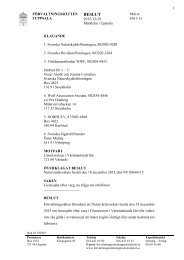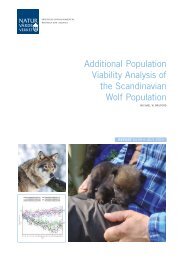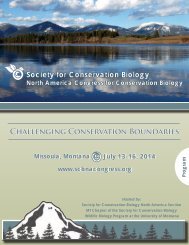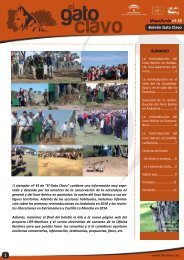1oC3Dbk
1oC3Dbk
1oC3Dbk
Create successful ePaper yourself
Turn your PDF publications into a flip-book with our unique Google optimized e-Paper software.
Setting global standards for the identification of sites of<br />
biodiversity conservation significance (Global standard<br />
for defining and identifying “key biodiversity areas”<br />
developed and adopted)<br />
Following the recommendations resulting from the high-level<br />
“Framing” meeting held in Cambridge in 2012, several<br />
technical workshops have been organized this year:<br />
• The Criteria and Delineation workshop (11–15 March 2013,<br />
Front Royal, USA – 40 participants) was dedicated to define the<br />
criteria of the new KBA standard, building on existing criteria<br />
and to agree on key considerations for delineating KBAs.<br />
• The Threshold workshop (2–5 December 2013, Rome, Italy<br />
– about 30 participants) established thresholds for measures<br />
of biodiversity significance, in other words at defining how<br />
“key” a site needs to be for it to be considered a “Key<br />
Biodiversity Area”.<br />
• The Governance workshop (6–9 November 2013, Brasilia,<br />
Brazil – about 40 participants) focused on the governance<br />
mechanisms of this new standard.<br />
• A Joint Marine Working Group has been created in<br />
collaboration with the Global Ocean Biodiversity Initiative<br />
(GOBI) to strengthen the synergies between the identification<br />
of EBSAs and the KBA process. In particular, Key<br />
Biodiversity Areas could provide a list of potential sites to be<br />
considered for the Ecologically and Biologically Significant<br />
Areas (EBSAs) adopted by the Convention on Biological<br />
Diversity. A workshop was organized during the International<br />
Marine Protected Areas Congress 3 (IMPAC3), in Marseille,<br />
France, on 22 October 2013, to look at marine Key<br />
Biodiversity Areas challenges, in particular with regards to<br />
large mobile marine species.<br />
• Interviews were conducted with various stakeholders and<br />
end-users (such as the World Bank, donors, NGOs,<br />
Indigenous people and local communities, etc.) on their<br />
needs and use of the KBA methodology.<br />
• Finally, regional presentations and consultations have been<br />
organized during existing regional events, such as the<br />
“Biodiversity without Boundaries”, in Baltimore (USA) on 17<br />
April 2013.<br />
The results of these technical workshops will be integrated into<br />
a draft methodology that will be available for comment next<br />
year, before being launched in November 2014 at the World<br />
Parks Congress, Sydney (Australia). A newsletter is sent out<br />
periodically and the website has been updated. For more<br />
information, please contact Annabelle.cuttelod@iucn.org.<br />
utilize the European and Global IUCN Red List data sets. A<br />
number of key publications will be submitted early 2014.<br />
Freshwater Biodiversity Unit, freshwater KBAs: We held<br />
our first two KBA workshops (Bosnia for the Balkans Region;<br />
Morocco for the Northern Africa region) to obtain stakeholder<br />
input to validate sites of proposed freshwater KBAs.<br />
Approximately 150 new sites have been identified. Once<br />
processing is completed these new KBAs will be represented<br />
in the World Biodiversity Database which has now been<br />
modified (under Biofresh) to accept and display freshwater<br />
data sets. Many members of the SSC Specialists Groups<br />
provided excellent input at these workshops.<br />
FBU is also involved in the drafting of the CEPF ecosystem<br />
Profile for the West Africa Guinea Forest Hotspot in<br />
collaboration with IUCN PACO.<br />
Invasive Species Initiative: Criteria for KBAs: ISI is involved in<br />
a process to identify and describe KBAs for the extensive lake<br />
and catchment of Lake Victoria in East Africa and its catchment<br />
in five countries in order to then assess the various levels of<br />
threat to such KBAs from invading species – and then to<br />
develop solutions for their better management of these threats.<br />
At the same time, ISI is assisting the Lake Victoria Basin<br />
Commission to streamline monitoring systems for the allpervading<br />
water hyacinth invasion and also to assess the water<br />
hyacinth extent and impacts across continental African states<br />
(on behalf of UNEP) and to suggest lasting means of<br />
management of this alien water weed – inside and out of KBAs.<br />
Re-introductions (Information and advice service in<br />
place to support species reintroductions)<br />
GSP assisted the Reintroduction Specialist Group in<br />
communicating their work and distributing the new<br />
Reintroduction Guidelines.<br />
Conservation Breeding, and links to ex-situ community<br />
(Advice and facilitation in place to support ex-situ<br />
species recovery programmes)<br />
Dena Cator participated in the CBSG Strategic Committee<br />
Meeting that took place in April. GSP regularly interacts with<br />
the World Association of Zoos and Aquariums (WAZA) which is<br />
Applying IUCN standard for identification of sites of<br />
global biodiversity conservation significance<br />
(Biodiversity conservation action improved through the<br />
application of consolidated standards)<br />
Release of Wood Bison from transport crates – Russia. © IUCN SSC<br />
Reintroduction Specialist Group<br />
Freshwater Biodiversity Unit, BIOFRESH project:<br />
FBU continues to lead Work Package “Informing Policy for<br />
Conservation Planning” providing input to the European<br />
Science Policy Interface relating to: i) Freshwater KBAs as<br />
input to systematic conservation planning for “efficient” site<br />
networks for freshwater species; ii) gap analyses in relation<br />
to Protected Areas; iii) predicted species range shifts under<br />
climate change scenarios, and iv) optimal site networks for<br />
maximising Ecosystem Service provisions. These analyses<br />
16 IUCN species Annual Report 2013






